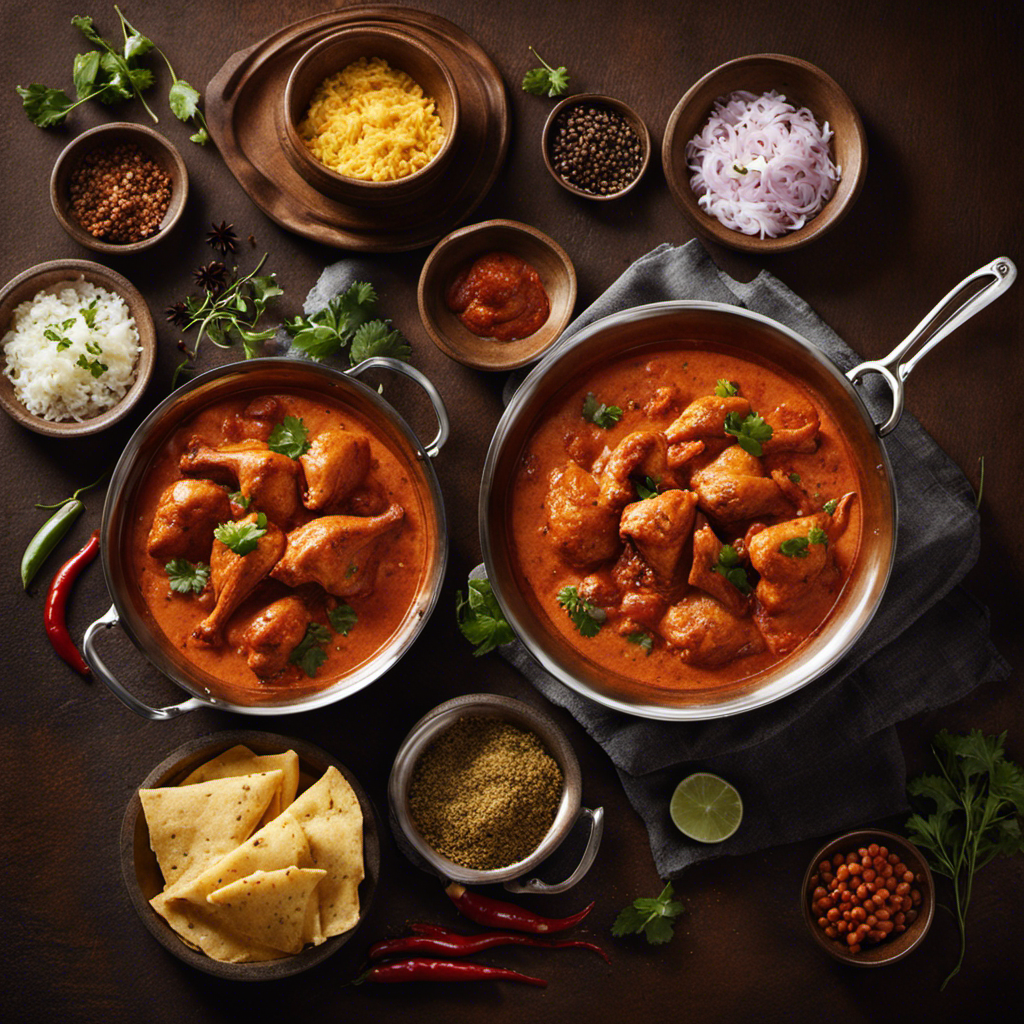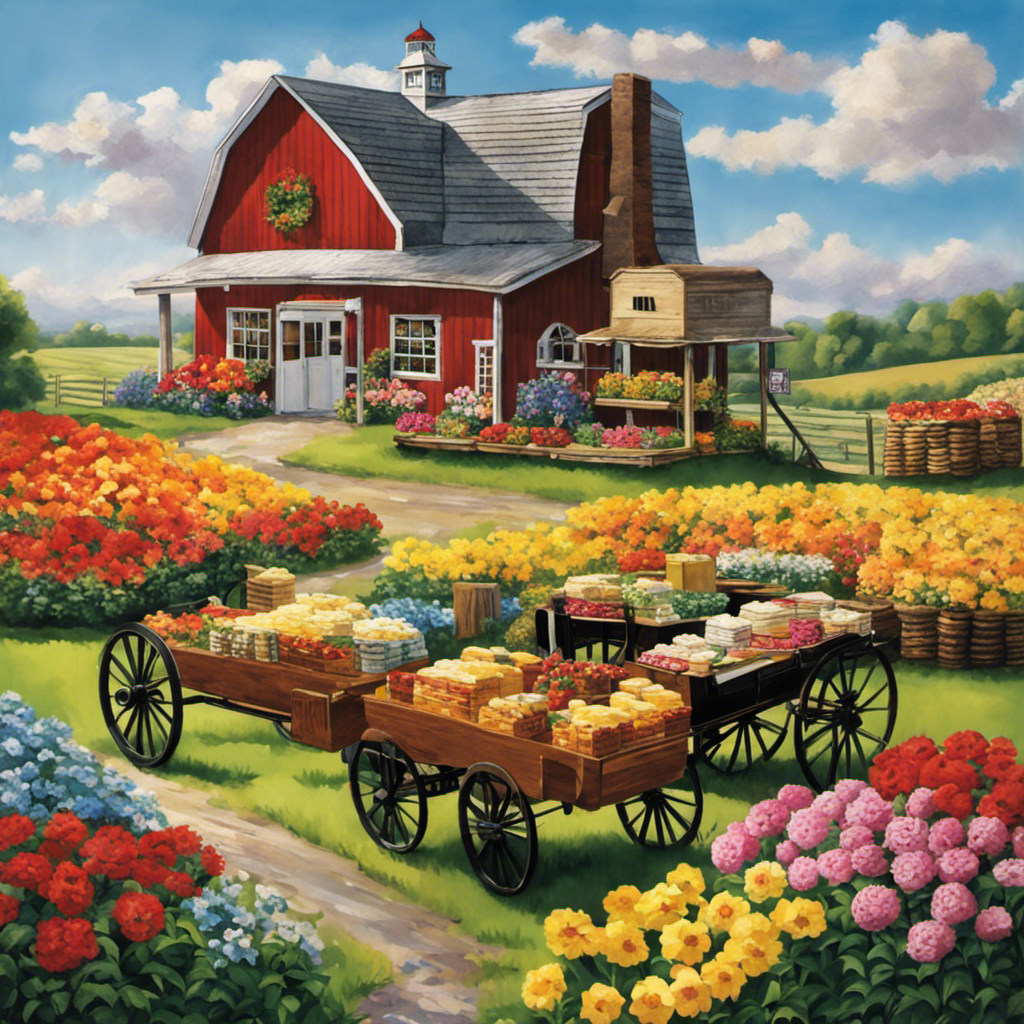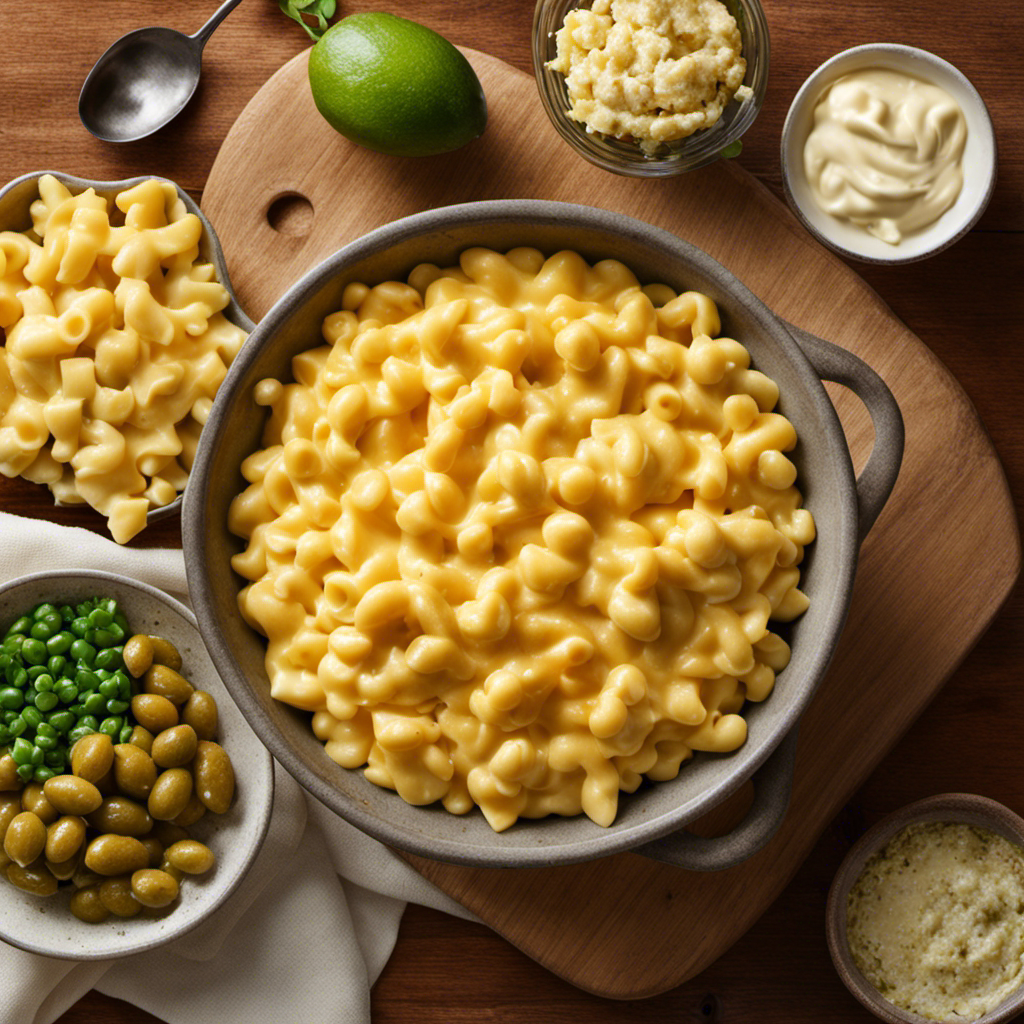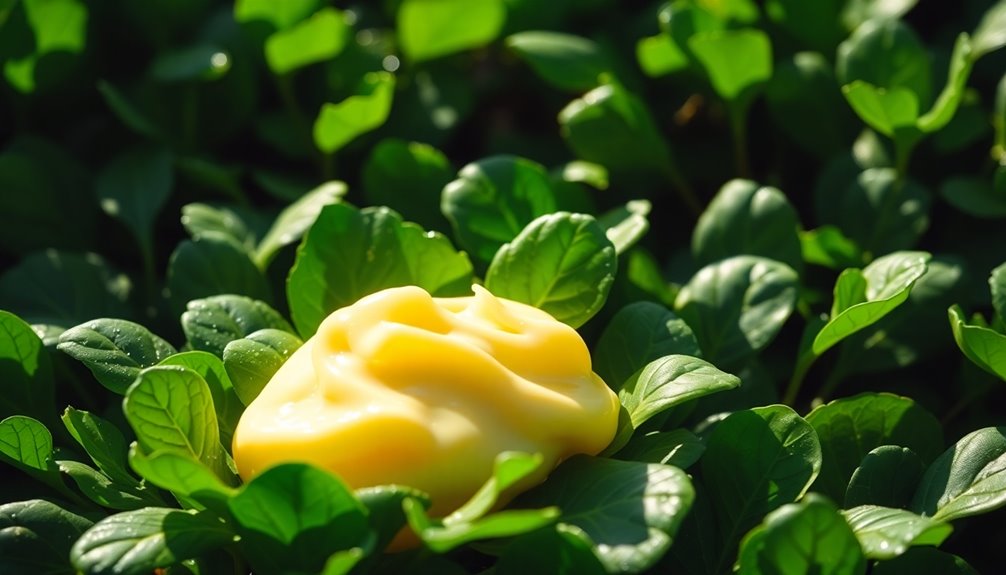My absolute favorite is butter chicken! It’s amazing how this tasty dish, with its creamy, rich sauce and juicy chicken, has such an interesting background.
Prepare to be amazed as we dive into the history and origins of butter chicken. From its humble beginnings in India to its global popularity today, we’ll explore the traditional ingredients, regional variations, and even compare it to its close cousin, chicken tikka masala.
So grab a napkin and get ready to discover the mouthwatering world of butter chicken.
Key Takeaways
- Butter chicken originated in the Indian subcontinent, specifically in the Punjab region or Mughal cuisine.
- The traditional recipe involves marinating chicken in yogurt and spices, cooking it in a tandoor, and then simmering it in a tomato-based gravy enriched with butter and cream.
- Key spices used in butter chicken include garam masala, turmeric, cumin, coriander, and chili powder, which add depth and complexity to the dish.
- Butter chicken has gained global popularity and has become a beloved international dish with regional adaptations in different countries.
History and Origins
Butter chicken is believed to have originated in the Indian subcontinent. The dish has a rich history and its origins can be traced back to traditional cooking methods of the region.
Over time, the recipe for butter chicken has evolved and adapted to different culinary influences. Originally, the dish was made by marinating chicken pieces in yogurt and spices, and then cooking them in a tandoor, a traditional clay oven. The chicken was then simmered in a tomato-based gravy, enriched with butter and cream. This combination of flavors and cooking techniques created a dish that was both flavorful and indulgent.
As the dish gained popularity, variations and adaptations emerged, incorporating different spices and ingredients. With its unique blend of flavors and textures, butter chicken has become an iconic dish that represents the diverse culinary heritage of the Indian subcontinent.
Moving on to the next section, let’s explore the traditional ingredients that make up this delectable dish.
Traditional Ingredients
When it comes to butter chicken, one of the key points to discuss is the spices used in the dish. The combination of spices like garam masala, turmeric, and cumin gives butter chicken its distinct flavor profile.
However, it’s important to note that the specific spices used can vary depending on the regional variations in the recipe.
This brings us to another point of discussion, which is the authenticity of the traditional butter chicken recipe. While there may be different versions of butter chicken, the debate over what constitutes the most authentic recipe continues among food enthusiasts and experts.
Spices in Butter Chicken
The spices in butter chicken are what give it its delicious and aromatic flavor. Indian cuisine is known for its vibrant use of spices, and butter chicken is no exception. The key spices used in this popular dish include garam masala, turmeric, cumin, coriander, and chili powder.
These spices not only add depth and complexity to the dish, but they also offer numerous health benefits. Turmeric, for example, contains a compound called curcumin, which has powerful anti-inflammatory and antioxidant properties. Cumin has been shown to aid digestion and improve blood sugar control. Coriander is rich in vitamins and minerals, while chili powder can boost metabolism and promote weight loss.
Regional Variations in Recipe
To create regional variations in your recipe, you can experiment with different spices and herbs. Here are three ways you can add a unique twist to your butter chicken:
-
Regional variations in preparation: Different regions in India have their own methods of preparing butter chicken. For example, in Punjab, the dish is often marinated overnight with a mix of yogurt, spices, and lemon juice, which gives it a tangy flavor. In Delhi, the gravy is made using tomatoes, cream, and a blend of spices, resulting in a rich and creamy texture. By researching and incorporating these regional techniques, you can create a butter chicken that reflects the flavors of a specific region.
-
Different cooking techniques: Another way to add variety to your butter chicken is by trying different cooking methods. While the traditional method involves simmering the chicken in a tomato-based gravy, you can also try grilling or baking the chicken before adding it to the sauce. This can give the dish a smoky or charred flavor, adding a new dimension to the dish.
-
Experimenting with spices and herbs: Apart from the standard spices like cumin, coriander, and garam masala, you can experiment with regional spices to create unique flavors. For example, adding Kashmiri red chili powder can give the dish a vibrant red color and a mild heat. Alternatively, using fenugreek leaves (kasuri methi) can add a slightly bitter and earthy flavor to the gravy. By exploring different spices and herbs, you can create a butter chicken recipe that is truly your own.
By incorporating regional variations in preparation, trying different cooking techniques, and experimenting with spices and herbs, you can create a butter chicken recipe that is diverse and full of exciting flavors.
Authenticity of Traditional Recipe
If you want an authentic taste, make sure to use traditional spices and cooking methods.
The authenticity debate surrounding butter chicken revolves around the question of what constitutes a truly traditional recipe. Some argue that the dish originated in the Punjab region of India, while others claim it has roots in the Mughlai cuisine of northern India.
Regardless of its origins, it is clear that butter chicken has evolved over time, with modern variations incorporating different ingredients and techniques. While some purists may argue that these variations stray too far from the traditional recipe, others appreciate the creativity and innovation that comes with experimenting in the kitchen.
Ultimately, the choice between sticking to tradition or embracing modern variations is a matter of personal preference.
Regional Variations
When it comes to butter chicken, it has become a dish that is enjoyed worldwide.
However, as it has traveled to different regions, there have been popular adaptations made to suit local tastes and preferences.
This brings up the debate of authenticity versus fusion, as some argue that the original recipe should be preserved while others embrace the evolution of the dish.
Butter Chicken Worldwide
Have you ever tried butter chicken from different parts of the world? It’s a popular dish that originated in India, but it has gained popularity worldwide.
Here are some interesting facts about butter chicken from around the globe:
-
Health Benefits:
- Butter chicken is a good source of protein, which helps in muscle growth and repair.
- It contains spices like turmeric, ginger, and garlic, which have anti-inflammatory properties.
- The dish is rich in vitamins and minerals, such as vitamin C and iron.
-
Vegetarian Options:
- In addition to the traditional chicken version, there are vegetarian alternatives available.
- Paneer butter masala is a popular vegetarian option, where paneer (cottage cheese) replaces the chicken.
- Tofu butter masala is another alternative, where tofu is used instead of chicken.
-
Global Variations:
- In the United States, butter chicken is often served with a creamier tomato-based sauce.
- In the United Kingdom, the dish is known as ‘chicken tikka masala’ and is a staple in many Indian restaurants.
- In Malaysia, butter chicken is often spicier and includes a variety of herbs and spices.
Overall, butter chicken has become a beloved dish worldwide, with various regional adaptations and vegetarian options available. It not only satisfies taste buds but also offers some health benefits.
Popular Regional Adaptations
One popular regional adaptation of butter chicken is the creamier tomato-based sauce served in the United States. This variation of butter chicken is often referred to as ‘American butter chicken’ or ‘creamy butter chicken.’ It is characterized by a richer and more indulgent sauce compared to the traditional Indian version.
The creaminess is achieved by adding heavy cream or yogurt to the tomato base, resulting in a velvety texture and a slightly sweeter taste. This regional adaptation reflects the cultural significance of butter chicken in the United States, where flavors are often modified to suit local palates.
The creamier tomato-based sauce has gained popularity among Americans who enjoy a milder and more comforting version of this classic Indian dish.
Authenticity Vs Fusion
If you want to experience the true flavors of traditional Indian cuisine, you should consider trying authentic dishes instead of fusion variations. While fusion cuisine can offer exciting and innovative combinations, it often dilutes the authenticity and distinctiveness of traditional recipes.
Here are three reasons why authentic Indian dishes are worth exploring:
-
Preservation of Heritage: Authentic Indian cuisine is a reflection of centuries-old culinary traditions and regional diversity. It allows you to taste the unique flavors and spices that have been passed down through generations.
-
Complexity of Flavors: Traditional Indian dishes are known for their complex flavor profiles, created by skillful blending of spices and ingredients. Fusion variations may simplify or alter these flavors, missing out on the depth and richness they offer.
-
Cultural Experience: By embracing authentic Indian cuisine, you immerse yourself in the culture and history of the country. Each dish tells a story and represents a specific region or community.
By savoring authentic Indian dishes, you can truly appreciate the depth and diversity of the country’s culinary heritage.
Now, let’s delve into popular accompaniments that enhance the flavors of these traditional delicacies.
Popular Accompaniments
You can’t go wrong with some fluffy naan and aromatic basmati rice as popular accompaniments to butter chicken. These regional accompaniments perfectly complement the rich and flavorful butter chicken gravy. However, in recent years, there has been a rise in modern twists on these traditional accompaniments, offering a unique and innovative dining experience.
To give you an idea of the variety available, here is a table showcasing some popular regional accompaniments and their modern twists:
| Regional Accompaniments | Modern Twists |
|---|---|
| Raita | Avocado Raita |
| Pickles | Mango Chutney |
| Papad | Spiced Pita Chips |
| Salad | Cucumber-Tomato Salsa |
These modern twists add a contemporary touch to the classic butter chicken meal, giving it a new and exciting flavor profile. Whether you prefer the traditional accompaniments or the modern twists, both options are sure to enhance your enjoyment of this delicious dish.
Cultural Significance
In exploring the cultural significance of butter chicken, it is fascinating to delve into its rich history and the traditions that have shaped it. This iconic dish has deep roots in Indian cuisine and holds a special place in the hearts and palates of people around the world.
Here are three key cultural influences that have contributed to the popularity and enduring appeal of butter chicken:
-
Punjabi Cuisine: Butter chicken originated in the Punjab region of India, known for its robust and flavorful dishes. The use of aromatic spices like garam masala and the combination of creamy tomato sauce and tender chicken reflect the culinary traditions of this region.
-
Mughal Influence: The Mughals, who ruled India during the 16th and 17th centuries, greatly influenced Indian cuisine. Butter chicken showcases the Mughal technique of marinating meat in yogurt and spices, resulting in tender and flavorful chicken.
-
Globalization: As Indian cuisine gained popularity worldwide, butter chicken became a beloved dish in international menus. Its unique blend of flavors, creamy texture, and comforting taste has made it a staple in many multicultural communities.
These cultural traditions and influences have helped shape butter chicken into the beloved dish it is today, representing the fusion of history, flavor, and culinary artistry.
Butter Chicken Vs. Chicken Tikka Masala
The comparison between butter chicken and chicken tikka masala reveals distinct differences in their flavor profiles and cooking techniques.
Butter chicken, also known as murgh makhani, is a popular Indian dish that originated in the 1950s in Delhi. It is made by marinating chicken in a mixture of yogurt and spices, then cooking it in a rich tomato-based sauce. The result is a creamy and mildly spiced dish that is often served with naan or rice.
On the other hand, chicken tikka masala is a British adaptation of Indian cuisine. It is made by grilling marinated chicken and then simmering it in a spicy tomato-based sauce. The flavors of chicken tikka masala are bolder and more intense compared to butter chicken.
Both dishes have gained cultural significance and are enjoyed by people around the world.
Famous Butter Chicken Recipes
Now that we have compared Butter Chicken and Chicken Tikka Masala, let’s explore some famous Butter Chicken recipes. This iconic dish has gained popularity all over the world, and many restaurants have put their own unique variations on the classic recipe. Here are three famous restaurants known for their delicious Butter Chicken:
-
Moti Mahal Delux in Delhi, India: This restaurant is credited with inventing Butter Chicken in the 1950s. Their recipe uses a combination of yogurt, cream, and spices to create a rich and creamy gravy.
-
Bukhara in New Delhi, India: Known for its signature smoky flavors, Bukhara’s Butter Chicken is cooked in a tandoor, giving it a unique charred taste. The dish is marinated with a blend of spices and yogurt before being cooked to perfection.
-
Dishoom in London, United Kingdom: This trendy Indian restaurant has put its own spin on Butter Chicken by adding a touch of fenugreek and a hint of green chili. Their recipe balances the flavors perfectly, resulting in a dish that is both creamy and spicy.
These famous restaurants showcase the diverse and delicious variations of Butter Chicken, proving that this dish has truly become a global favorite.
Butter Chicken Around the World
From India to the United Kingdom, Butter Chicken has become a beloved international dish with various regional adaptations. This popular Indian curry dish, also known as Murgh Makhani, has found its way onto menus all around the world, each with its own unique twist.
In India, the birthplace of Butter Chicken, it is traditionally made with chicken marinated in yogurt and spices, cooked in a rich tomato-based gravy. However, as it spread across the globe, different countries and cultures have put their own spin on the dish. For example, in the United Kingdom, the addition of cream and butter gives it a creamier texture, while in Malaysia, it is spiced up with chili and other local ingredients.
The regional adaptations of Butter Chicken not only showcase the creativity and diversity of global cuisines, but also highlight its cultural significance as a dish that brings people together, bridging culinary traditions from different parts of the world.
Frequently Asked Questions
Is Butter Chicken a Traditional Dish?
Butter chicken is a popular dish globally. It is prepared differently in various countries, with variations in spices and cooking methods. The dish is loved for its rich and creamy taste.
What Are the Main Ingredients in Butter Chicken?
The main ingredients in butter chicken are chicken, butter, tomato sauce, cream, and various spices. To make butter chicken at home, you need to marinate the chicken, cook it in a tomato-based sauce, and finish it with butter and cream.
Are There Any Variations of Butter Chicken Based on Different Regions?
There are various types of curries found in Indian cuisine, each with its own regional influences. One popular variation is butter chicken, a rich and creamy dish that can be easily made at home.
What Are Some Popular Side Dishes That Go Well With Butter Chicken?
The best vegetarian options to pair with butter chicken are naan bread, rice, and vegetable biryani. As for fusion recipes, butter chicken can be used as a filling for tacos or as a topping for pizza.
How Does Butter Chicken Compare to Chicken Tikka Masala?
When comparing butter chicken to chicken tikka masala, I found that they are both popular Indian curries with rich flavors. However, butter chicken originated in Punjab, while chicken tikka masala has roots in the UK.
Conclusion
After conducting extensive research on the origins and cultural significance of butter chicken, it’s clear that this delicious dish has a rich history and has evolved over time.
From its humble beginnings in India to its popularity around the world, butter chicken has become a beloved staple in many cuisines. With its flavorful combination of spices and creamy tomato sauce, it’s no wonder that butter chicken has gained such widespread acclaim.
So next time you’re craving a taste of history and culture, don’t hesitate to indulge in this timeless dish.










